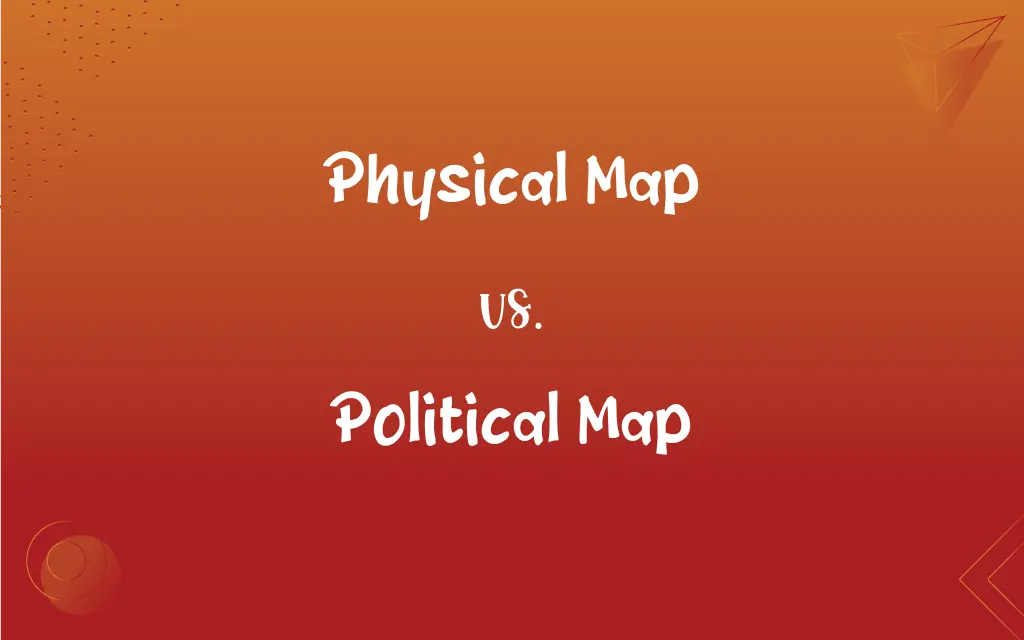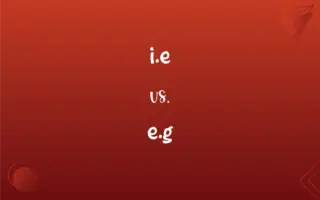Physical Map vs. Political Map: What's the Difference?
By Aimie Carlson & Harlon Moss || Updated on October 3, 2023
A physical map depicts geographical features, while a political map shows the division of territories, states, and countries.

Key Differences
A physical map primarily illustrates the physical features of a geographical area, like mountains, rivers, and lakes. In contrast, a political map provides a representation of territorial, state, and international borders, showcasing the division of areas under different governing bodies.
Physical maps utilize variations in color and shading to display differences in terrain and elevation, enabling users to understand the physical landscape of a region. Political maps, on the other hand, utilize distinct border lines and varied colors to differentiate between different countries, states, or territories, facilitating an understanding of geopolitical boundaries.
The use of symbols and colors on a physical map is usually geared towards representing variations in the Earth's landscape, such as differentiating between varying elevations or types of landforms. Symbols on a political map generally pertain to capitals, major cities, and sometimes include significant infrastructure such as highways or airports.
Explorers or travelers might favor physical maps to understand the nature of the terrain they will encounter. Conversely, political maps might be preferred by individuals studying or working in fields related to international relations, governance, or logistics due to their focus on boundaries and governmental divisions.
Physical maps tend to emphasize the natural aspects of Earth, providing detailed insight into the topographical and environmental attributes of a location. Whereas political maps highlight human-made divisions and provide a clear visualization of political entities and their administrative divisions.
ADVERTISEMENT
Comparison Chart
Primary Focus
Represents physical geographical features
Represents geopolitical boundaries
Color Utilization
Colors represent variations in elevation/terrain
Colors differentiate countries or states
Symbol Representation
Symbols typically denote physical landmarks
Symbols usually denote cities, capitals, etc.
Common Use
Utilized for understanding terrain and geography
Utilized for understanding geopolitical divisions
Details
Includes landforms like mountains, valleys, etc.
Includes borders, cities, and other political entities
ADVERTISEMENT
Physical Map and Political Map Definitions
Physical Map
Physical maps offer a representation of the Earth’s natural features without political boundaries.
The physical map displayed the vast desert without indicating country borders.
Political Map
Political maps utilize varied colors to differentiate between different countries or states.
Children often use a political map to learn about the different countries represented in various colors.
Physical Map
A physical map can show different types of bodies of water.
Sailors may refer to a physical map to locate islands and bays.
Political Map
A political map represents the territorial boundaries of countries and states.
The political map clearly showcased the distinct borders between neighboring countries.
Physical Map
A physical map highlights the natural terrain and landforms of an area.
Hikers often use a physical map to navigate through varied terrains.
Political Map
Political maps often come in handy for understanding geopolitical scenarios.
Analysts refer to political maps to discuss international relations and policy.
Physical Map
Physical maps can include details like mountain ranges, plains, and plateaus.
The physical map was instrumental in planning the cross-country journey.
Political Map
Political maps typically include significant cities and capital markers.
The student used a political map to locate the capital cities of European countries.
Physical Map
Physical maps utilize color gradients to depict elevation changes.
The physical map revealed the mountain ranges with different shades of brown.
Political Map
A political map may display major transportation routes and infrastructures.
The political map was consulted to understand the highway networks between states.
FAQs
What is a physical map?
A physical map illustrates the physical features of a geographical area such as mountains, rivers, and deserts.
What information does a political map provide?
A political map provides information about political boundaries, locations of cities, and the division of governmental territories.
Are physical maps used for navigation?
Yes, physical maps are often used for navigation, especially in activities like hiking, where understanding the terrain is crucial.
How are territories usually marked on a political map?
On a political map, territories are often marked with distinct boundary lines and may be colored differently to distinguish them from countries.
Why are political maps important for students?
Political maps are important for students to understand geopolitical boundaries, locations of various countries, states, and cities, enhancing their global awareness.
Is it possible for a political map to show disputed territories?
Yes, political maps often indicate disputed territories with special markings, such as dashed or colored lines, and may label them accordingly.
Can a physical map show weather patterns?
Physical maps generally focus on static geographical features and typically do not show weather patterns, which are often depicted on meteorological maps.
How are countries typically labeled on a political map?
Countries on a political map are usually labeled with their names, and often include the locations of major cities and capitals.
Can a political map display cultural or linguistic boundaries?
Political maps typically focus on legal and governmental boundaries, while cultural or linguistic boundaries are often highlighted on ethnolinguistic maps.
Can a political map be used to analyze election results?
Yes, a specialized form of political map, often called an electoral map, is used to depict regions' voting results in elections.
What is the importance of a legend on a physical map?
A legend on a physical map explains the symbols, colors, and lines used, providing crucial information to understand the map's depiction of geographical features.
Do political maps always reflect the current geopolitical scenario?
Political maps aim to represent the current geopolitical scenario, but due to geopolitical changes, maps may become outdated and need to be revised.
Can a physical map include details of vegetation types?
Yes, physical maps can include information about vegetation types, helping to showcase different biomes or habitats.
Is it common for a political map to show physical features?
While the primary focus is on political entities, some political maps also provide a subdued background of physical features for context.
In what professions are physical maps commonly utilized?
Physical maps are commonly used in professions like geology, environmental science, and geography for analyzing the physical characteristics of areas.
Do physical maps show roads and highways?
Physical maps primarily focus on geographical features, but some may include major roads and highways for reference.
What symbols are commonly found on a political map?
Common symbols on a political map include stars for capitals, dots for cities, and dashed or solid lines for boundaries.
Can a physical map display ocean currents?
Yes, some physical maps, especially those of oceanic regions, can depict ocean currents and water depths.
What scales are commonly used in physical maps?
Physical maps may use various scales, often opting for larger scales (e.g., 1:50,000) to show detailed geographical features.
How does a physical map depict elevation?
Physical maps depict elevation using contour lines, color gradients, or shading to illustrate terrain and altitude differences.
About Author
Written by
Aimie CarlsonAimie Carlson, holding a master's degree in English literature, is a fervent English language enthusiast. She lends her writing talents to Difference Wiki, a prominent website that specializes in comparisons, offering readers insightful analyses that both captivate and inform.
Co-written by
Harlon MossHarlon is a seasoned quality moderator and accomplished content writer for Difference Wiki. An alumnus of the prestigious University of California, he earned his degree in Computer Science. Leveraging his academic background, Harlon brings a meticulous and informed perspective to his work, ensuring content accuracy and excellence.































































